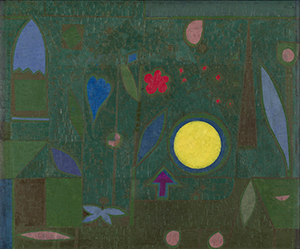
Full Moon in the Garden (Vollmond im Garten), 1934
Paul Klee
Full Moon in the Garden (Vollmond im Garten), 1934
Oil on canvas with printing
50.3 x 60.1 cm
Hermann und Margrit Rupf-Stiftung, Kunstmuseum Bern
© Paul Klee's Estate/VEGAP, 2016
“Color possesses me. I don't have to pursue it. It will possess me always, I know it. That is the meaning of this happy hour: Color and I are one. I am a painter.” Paul Klee, 1914[1]
Paul Klee (Münchenbuchsee, Switzerland, 1879—Muralto, Switzerland, 1940) and the collector Hermann Rupf (1880–1962) met in Bern (Switzerland) in 1913 on one of the artist’s trips back home to visit his family [2]. One year after meeting him, attracted by his work, Hermann and his wife Margrit (1887–1961) decided to purchase a group of three drawings by the painter; this marked their first purchase [3]. In the subsequent years, they continued to collect Klee’s works and became close to the artist and his wife Lily.
For several years, Klee worked in the Bauhaus schools in Weimar, where he had moved in 1922, and Dessau. After 1931, shortly before the Nazis closed the Bauhaus, Klee began to teach at the Düsseldorf Academy. After Hitler was made Chancellor of Germany in 1933, his situation became fraught. In mid-March of that same year, the Nazi police (Ordnungspolizei) entered his apartment when he was gone and confiscated his materials [4]. Fearful of being arrested, Klee immediately fled the country and took refuge in Switzerland for a few weeks; in the meantime, his works were seized and labelled as “degenerate art” [5]. Finally, Klee was stripped of his position as an instructor at the Düsseldorf Academy after being disparaged on official posters and in the German press [6]. In December 1933, after a jobless stint, Klee was forced to leave Germany, and he and his wife sought refuge in his parents’ house in Bern [7]. His friends Hermann and Margrit Rupf and the dealer Daniel-Henry Kahnweiler (1880–1962) awaited him in Switzerland. Through the mediation of his close friend Rupf, Kahnweiler became Klee’s exclusive representative abroad [8].
That same year, Klee began to experience the symptoms of an illness whose nature led his output to drop drastically. Full Moon in the Garden (Vollmond im Garten) was painted in 1934 at the onset of his illness. Kahnweiler took the painting to Paris and exhibited at the Galerie Simon, where Rupf purchased it. Klee was a key artist in Rupf’s collection, which contains a total of 190 of the painter’s works [9].
Preguntas
Take a careful look at Paul Klee’s work. Take your time to notice all the details. What do you see? What figures can you make out? Describe how Klee used color in this work. Does it convey any particular mood, feeling or sensation? Does this palette or color combination remind you of anything specific?
The title of the work is Full Moon in the Garden. How did the way you see the work change after learning its title? Do you think that Klee depicts any of the traits that a garden may have, or did he eliminate any trace of reality? Explain your answer. Do you think that this place may have really existed? Why? Imagine that you can leap inside the painting. What areas would you like to explore further? Is there any special part that intrigues you or draws your attention? Once you were there, what would you see? What would you smell? What or who would you hear?
